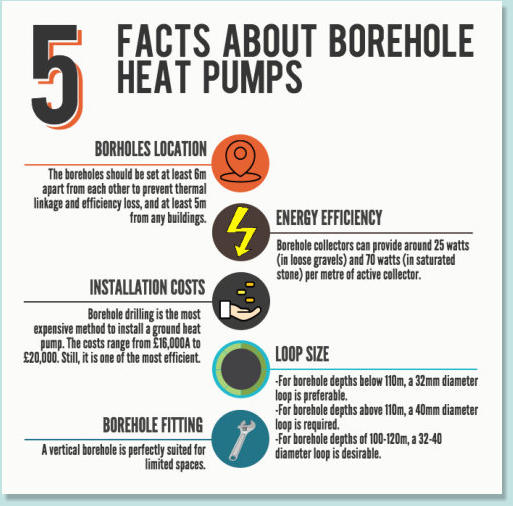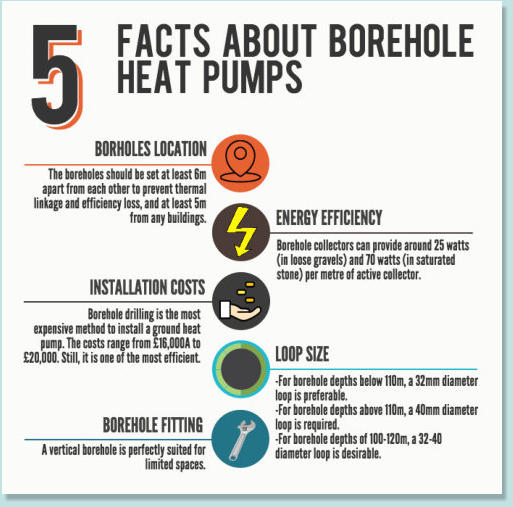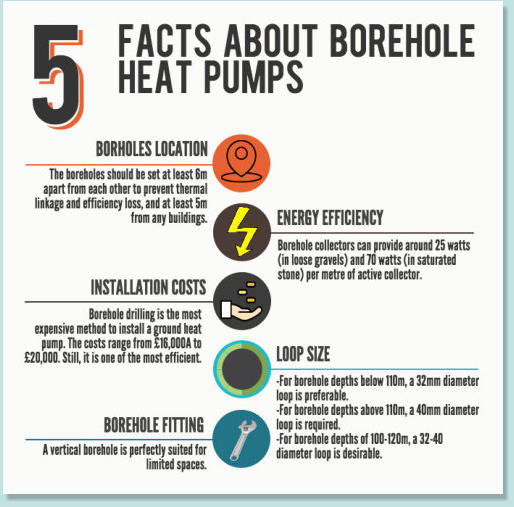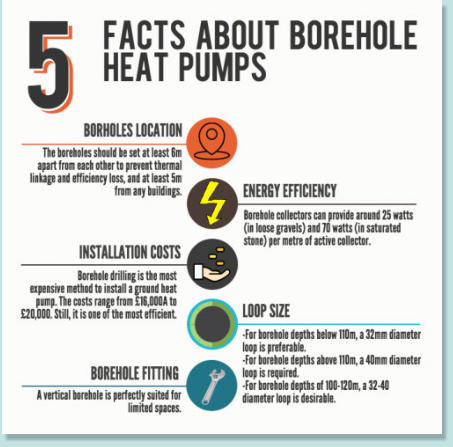Vertical boreholes are good for small or limited areas, and although it bears high installation costs, borehole heat collectors
produce a higher heat yield per metre, compared to horizontal collectors, which entails a better energy efficiency rate. Thus, if
you are considering drilling a borehole in your backyard, you’ll have to make sure that the ground is suitable for digging a
deep-seated ditch and that the designated area is accessible for fitting in the drilling equipment.
What is a Ground Source Heat Pump Borehole?
A borehole type heat pump represents a closed loop system which comprises a
set of polyethylene pipes that are vertically inserted into the ground and which
circulate water to and from the geothermal heat pump. In most cases, the
borehole size will range between 15m and 122 m (50-400 feet) deep.
The space between the pipes and the borehole wall is filled up with a special
grout mix that typically contains a combination of bentonite, sand and potable
water, which is being pumped from bottom to top. Bentonite is preferable to
other grouting materials, since it is waterproof and a good thermal conductor.
Therefore, by retaining a considerable amount of moisture it rarely dries out
which ensures a proper heat transfer from the ground to the pipe and vice versa.
At the same time, due to its low permeability properties, the bentonite grout
provides a self-sealing barrier to groundwater intrusion. The boreholes are
drilled at 5-6 m apart from each other and at 6-7 m from the nearest building.
The depth is conditional on the property’s characteristics (size, insulation,
heating capacity) that requires heating. A house that needs around 10 kW of
heating capacity, most probably will need three boreholes of 80 to 110 m deep.
Borehole Collectors Installation and Operational Costs
The costs associated with a borehole heat pump installation are directly proportional on such factors as borehole depth,
borehole casing and sealing materials dimensions. In order to make sure that you will make the most out of the boreholes you
are planning to drill, you can order a geotechnical survey to be carried out beforehand.
In so doing, you’ll be able to minimise the degree of uncertainty when it comes to the soil’s thermal properties assessment and
it will make sure that the heating capacity you are looking to obtain by installing a ground source heat pump will pay off the
initial investment. At the same time, a survey like this will provide a reliable amount of data that will be instrumental in planning
the right length and diameter of the borehole loop, that will correspond with the ground’s characteristics.
The smaller the system, the higher the cost per kW output will be. As mentioned earlier, for all the types of ground source heat
pumps that use a borehole as their main heat source collector, the setting up costs (planning, equipment utilisation and the
commission of works) are a substantial part of the total costs. Thus, the capital cost measured in pounds per borehole meter
that is being drilled, will decrease as the collector size increases.
This means that, for a group of ten houses which are located on the same site, the borehole collector costs per house will be
around 20% lower than for an individual house. Meanwhile, the overall costs of the heat pump that determines its’ output in
terms of pounds per kW, will drop as well, provided that the heat pump output gets larger.

Vertical boreholes are good for small or limited areas, and although it bears high installation costs,
borehole heat collectors produce a higher heat yield per metre, compared to horizontal collectors,
which entails a better energy efficiency rate. Thus, if you are considering drilling a borehole in your
backyard, you’ll have to make sure that the ground is suitable for digging a deep-seated ditch and
that the designated area is accessible for fitting in the drilling equipment.
What is a Ground Source Heat Pump Borehole?
A borehole type heat pump represents a closed
loop system which comprises a set of
polyethylene pipes that are vertically inserted
into the ground and which circulate water to
and from the geothermal heat pump. In most
cases, the borehole size will range between
15m and 122 m (50-400 feet) deep.
The space between the pipes and the borehole
wall is filled up with a special grout mix that
typically contains a combination of bentonite,
sand and potable water, which is being pumped
from bottom to top. Bentonite is preferable to
other grouting materials, since it is waterproof
and a good thermal conductor. Therefore, by
retaining a considerable amount of moisture it
rarely dries out which ensures a proper heat
transfer from the ground to the pipe and vice
versa. At the same time, due to its low permeability properties, the bentonite grout provides a self-
sealing barrier to groundwater intrusion. The boreholes are drilled at 5-6 m apart from each other
and at 6-7 m from the nearest building. The depth is conditional on the property’s characteristics
(size, insulation, heating capacity) that requires heating. A house that needs around 10 kW of
heating capacity, most probably will need three boreholes of 80 to 110 m deep.
Borehole Collectors Installation and Operational Costs
The costs associated with a borehole heat pump installation are directly proportional on such
factors as borehole depth, borehole casing and sealing materials dimensions. In order to make
sure that you will make the most out of the boreholes you are planning to drill, you can order a
geotechnical survey to be carried out beforehand.
In so doing, you’ll be able to minimise the degree of uncertainty when it comes to the soil’s thermal
properties assessment and it will make sure that the heating capacity you are looking to obtain by
installing a ground source heat pump will pay off the initial investment. At the same time, a survey
like this will provide a reliable amount of data that will be instrumental in planning the right length
and diameter of the borehole loop, that will correspond with the ground’s characteristics.
The smaller the system, the higher the cost per kW output will be. As mentioned earlier, for all the
types of ground source heat pumps that use a borehole as their main heat source collector, the
setting up costs (planning, equipment utilisation and the commission of works) are a substantial
part of the total costs. Thus, the capital cost measured in pounds per borehole meter that is being
drilled, will decrease as the collector size increases.
This means that, for a group of ten houses which are located on the same site, the borehole
collector costs per house will be around 20% lower than for an individual house. Meanwhile, the
overall costs of the heat pump that determines its’ output in terms of pounds per kW, will drop as
well, provided that the heat pump output gets larger.

Biomass Installer Yorkshire
Balcas Brites
Biomass Pellet Supplier
Biomass Boilers Yorkshire
Biomass Boilers
Biomass Yorkshire
MCS
AECB
Biomass Lancashire
Biomass Heating Yorkshire
Biomass Heating
Solar Heating
Biomass Boilers
Solar PV
Biomass heat Yorkshire
Fit Tarriffs
ASHP Yorkshire
ASHP Lancashire
GSHP Yorkshire
ASHP Lancashire
Vertical boreholes are good for small or limited areas, and
although it bears high installation costs, borehole heat
collectors produce a higher heat yield per metre,
compared to horizontal collectors, which entails a better
energy efficiency rate. Thus, if you are considering drilling
a borehole in your backyard, you’ll have to make sure that
the ground is suitable for digging a deep-seated ditch and
that the designated area is accessible for fitting in the
drilling equipment.
What is a Ground Source Heat Pump Borehole?
A borehole type heat pump represents a closed loop
system which comprises a set of polyethylene pipes that
are vertically inserted into the ground and which circulate
water to and from the geothermal heat pump. In most
cases, the borehole size will range between 15m and 122
m (50-400 feet) deep.
The space between the pipes and the borehole wall is
filled up with a special grout mix that typically contains a
combination of bentonite, sand and potable water, which
is being pumped from bottom to top. Bentonite is
preferable to other grouting materials, since it is
waterproof and a good thermal conductor. Therefore, by
retaining a considerable amount of moisture it rarely dries
out which ensures a proper heat transfer from the ground
to the pipe and vice versa. At the same time, due to its
low permeability properties, the bentonite grout provides a
self-sealing barrier to groundwater intrusion. The
boreholes are drilled at 5-6 m apart from each other and
at 6-7 m from the nearest building. The depth is
conditional on the property’s characteristics (size,
insulation, heating capacity) that requires heating. A
house that needs around 10 kW of heating capacity, most
probably will need three boreholes of 80 to 110 m deep.
Borehole Collectors Installation and Operational Costs
The costs associated with a borehole heat pump
installation are directly proportional on such factors as
borehole depth, borehole casing and sealing materials
dimensions. In order to make sure that you will make the
most out of the boreholes you are planning to drill, you
can order a geotechnical survey to be carried out
beforehand.
In so doing, you’ll be able to minimise the degree of
uncertainty when it comes to the soil’s thermal properties
assessment and it will make sure that the heating
capacity you are looking to obtain by installing a ground
source heat pump will pay off the initial investment. At the
same time, a survey like this will provide a reliable
amount of data that will be instrumental in planning the
right length and diameter of the borehole loop, that will
correspond with the ground’s characteristics.
The smaller the system, the higher the cost per kW output
will be. As mentioned earlier, for all the types of ground
source heat pumps that use a borehole as their main heat
source collector, the setting up costs (planning,
equipment utilisation and the commission of works) are a
substantial part of the total costs. Thus, the capital cost
measured in pounds per borehole meter that is being
drilled, will decrease as the collector size increases.
This means that, for a group of ten houses which are
located on the same site, the borehole collector costs per
house will be around 20% lower than for an individual
house. Meanwhile, the overall costs of the heat pump that
determines its’ output in terms of pounds per kW, will drop
as well, provided that the heat pump output gets larger.

Vertical boreholes are good for small or
limited areas, and although it bears high
installation costs, borehole heat collectors
produce a higher heat yield per metre,
compared to horizontal collectors, which
entails a better energy efficiency rate. Thus, if
you are considering drilling a borehole in your
backyard, you’ll have to make sure that the
ground is suitable for digging a deep-seated
ditch and that the designated area is
accessible for fitting in the drilling equipment.
What is a Ground Source Heat Pump
Borehole?
A borehole type heat pump represents a
closed loop system which comprises a set of
polyethylene pipes that are vertically inserted
into the ground and which circulate water to
and from the geothermal heat pump. In most
cases, the borehole size will range between
15m and 122 m (50-400 feet) deep.
The space between the pipes and the
borehole wall is filled up with a special grout
mix that typically contains a combination of
bentonite, sand and potable water, which is
being pumped from bottom to top. Bentonite is
preferable to other grouting materials, since it
is waterproof and a good thermal conductor.
Therefore, by retaining a considerable amount
of moisture it rarely dries out which ensures a
proper heat transfer from the ground to the
pipe and vice versa. At the same time, due to
its low permeability properties, the bentonite
grout provides a self-sealing barrier to
groundwater intrusion. The boreholes are
drilled at 5-6 m apart from each other and at
6-7 m from the nearest building. The depth is
conditional on the property’s characteristics
(size, insulation, heating capacity) that
requires heating. A house that needs around
10 kW of heating capacity, most probably will
need three boreholes of 80 to 110 m deep.
Borehole Collectors Installation and
Operational Costs
The costs associated with a borehole heat
pump installation are directly proportional on
such factors as borehole depth, borehole
casing and sealing materials dimensions. In
order to make sure that you will make the
most out of the boreholes you are planning to
drill, you can order a geotechnical survey to
be carried out beforehand.
In so doing, you’ll be able to minimise the
degree of uncertainty when it comes to the
soil’s thermal properties assessment and it
will make sure that the heating capacity you
are looking to obtain by installing a ground
source heat pump will pay off the initial
investment. At the same time, a survey like
this will provide a reliable amount of data that
will be instrumental in planning the right length
and diameter of the borehole loop, that will
correspond with the ground’s characteristics.
The smaller the system, the higher the cost
per kW output will be. As mentioned earlier,
for all the types of ground source heat pumps
that use a borehole as their main heat source
collector, the setting up costs (planning,
equipment utilisation and the commission of
works) are a substantial part of the total costs.
Thus, the capital cost measured in pounds per
borehole meter that is being drilled, will
decrease as the collector size increases.
This means that, for a group of ten houses
which are located on the same site, the
borehole collector costs per house will be
around 20% lower than for an individual
house. Meanwhile, the overall costs of the
heat pump that determines its’ output in terms
of pounds per kW, will drop as well, provided
that the heat pump output gets larger.

Tel: 01282 786900 Mob: 07790 215 065
© 2016 Reliable Renewables Ltd.

GSHP Boreholes

Tel: 01282 786900 Mob: 07790 215 065
© 2016 Reliable Renewables Ltd.
GSHP Boreholes

07790 215 065
© Copyright Reliable Renewables Ltd 2016
Tel:
01282 786900
Mob:
GSHP Boreholes

© Copyright Reliable Renewables Ltd 2016
Tel:
01282 786900
Mob:
07790 215 065
GSHP Boreholes





























